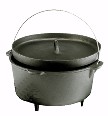I was pretty sure of myself in the woods and invited him to my favorite Missouri deep-woods wilderness. Although I knew he was an outdoorsman, hunter and scouter his gear and packing approach didn't fit my modern backpacker gearhead attitude I had created for myself. He had a decent pack and sleeping bag, but other than a few bare necessities and a plastic tarp, he brought along a bow saw and two coffee cans nested inside of a #10 can. He kept saying he had plenty of gear, as if he sensed my uneasiness about his spartan equipment.
With the bow saw he made quick work at the evening campsite. Using downed wood he produced a number of three foot long construction components made of around four inch diameter logs with a fork or "Y" at one end. He interlocked the "Y"s at the top and made tripods (called them "frogs") on which he laid rails and in no time we had benches and tables. Using this approach he built a frame for his 4 mil. poly tarp tent and a frame for his pack. The technique was startling in its simplicity.
He then made two star fires using four logs about six inches in diameter and a couple of feet long, and one log about three feet long. He placed the longest log facing at an angle to the wind, and the rest of the logs in a star arrangement with their ends together. In the hub between all of the logs he piled tinder and fired it up. He put the #10 can full of water right on top of the fire. I saw those star fires bring gallon after gallon of water to a boil in a few minutes and keep them at a moderately rolling boil all night. He occasionally kicked the ends of the logs into the hubs as they were consumed to keep the fires burning.

An eleven foot log, six inches in diameter produced the water boiling capability of easily five times that much wood in a conventional ground fire, or several gallons of stove fuel. When we went to bed we just took the pots off and pulled the logs away from themselves and the fire went right out. Next morning they were re-lit in no time. The environmental impact was extremely low, too. When we broke camp we only had to deal with about a twelve inch diameter pile of clean ashes which pretty much washed away when we doused the fire.
All of this new basic tech humbled my gear-weenie ass and I've used it ever since. Outdoor living always involves boiling water for purification and cooking. The star fire is very efficient at this. It even continues to boil water in the rain, since the fire is completely covered by the pot! All it takes is a bow saw to cut up the fuel and a pot to sit on top. The simple lash-less "frog" pioneering construction approach solves all kinds of structural and camp furniture issues, too.
He kept saying he had plenty of gear. He did.



